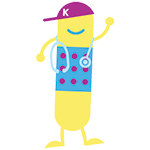How to use a Puffer
When a child has a persistent cough or difficulty breathing, some physicians will prescribe puffers to help.
These children may have asthma, with recurrent episodes of recurrent coughing or wheezing or they may have a viral infection that triggers an inflammatory response in the small airways.
Asthma is a chronic inflammatory disease of the airways.
Puffers can help open up the airways and clear pesky mucus and inflammation.
This can alleviate the cough and lead to better sleep.
Asthma is usually diagnosed clinically, with kids having recurrent episodes of persistent coughing or wheezing. Few children will require specialized testing called a methacholine challenge.
Symptoms of Asthma?
• Wheezing
• Shortness of breath
• Chest tightness
• Coughing
• Sputum production or vomiting mucous
The most common puffers I see used are Salbutamol (Ventolin) and Fluticasone (Flovent).
Here’s how they work:
Salbutamol
(‘the blue one’)
Salbutamol is a bronchodilator. It opens up the airways when they are tight. Salbutamol helps immediately and will work for a few hours. It is a rescue medication and is to be used when the child is coughing or having difficulty breathing. We typically use it every 4 hours as needed. I find most kids need it more often with sleep, eating or during exercise.
Fluticasone
(‘the orange one’)
Fluticasone is an inhaled steroid and decreases mucus and inflammation over time. We usually prescribe it be taken morning and night. The medicine will then work through the day to keep the lungs clear of inflammation.
I typically prescribe Salbutamol as needed where there are symptoms of coughing or difficulty breathing and stop when this is no longer a problem. If your child needs it every day, their asthma/cough is not well enough controlled.
Most children can use Fluticasone intermittently when their asthma/cough is flaring up. For virus-induced asthma, I start Fluticasone at the beginning of a cold till a week after it is over. This may keep it under better control and reduce visits to the emergency room.
Always use a spacer
(like Aerochamber):
The medicine doesn’t deposit in the lungs properly without an aero-chamber. These are plastic devices that space the medicine from the mouth to maximally deposit the particles in the lungs.
Without one, most of the medicine goes to the back of the throat, and what’s the point of that?
#YouGotThis
































